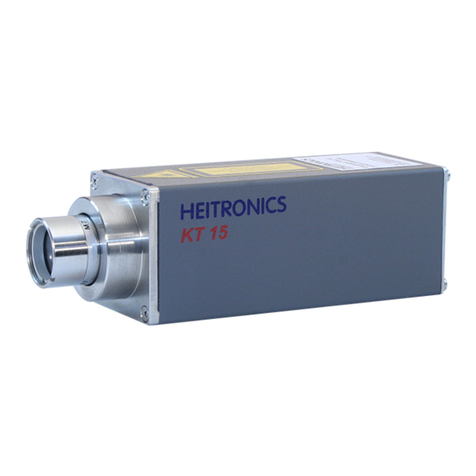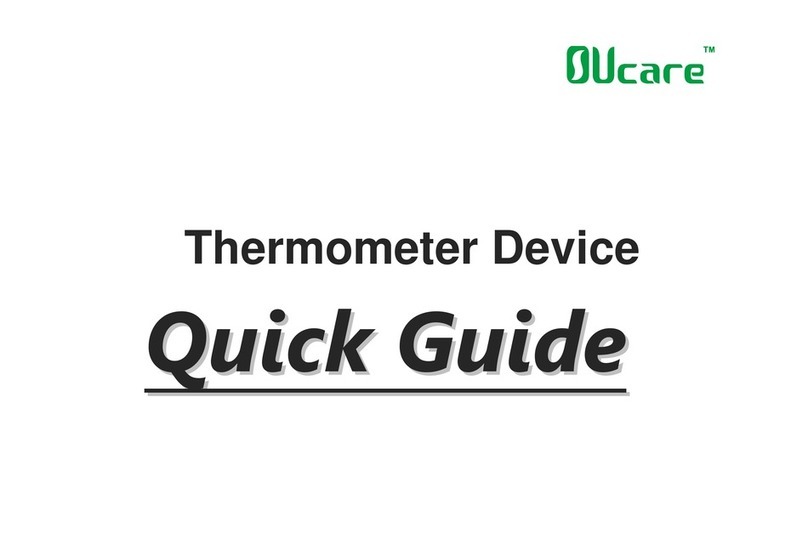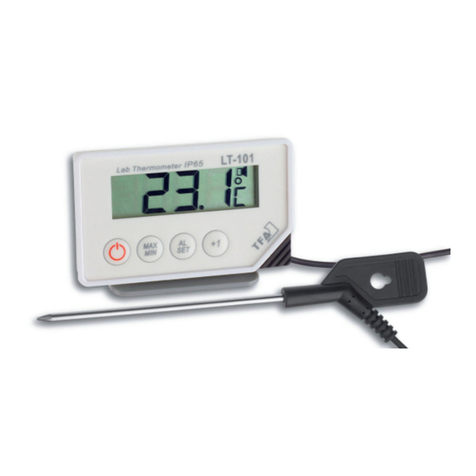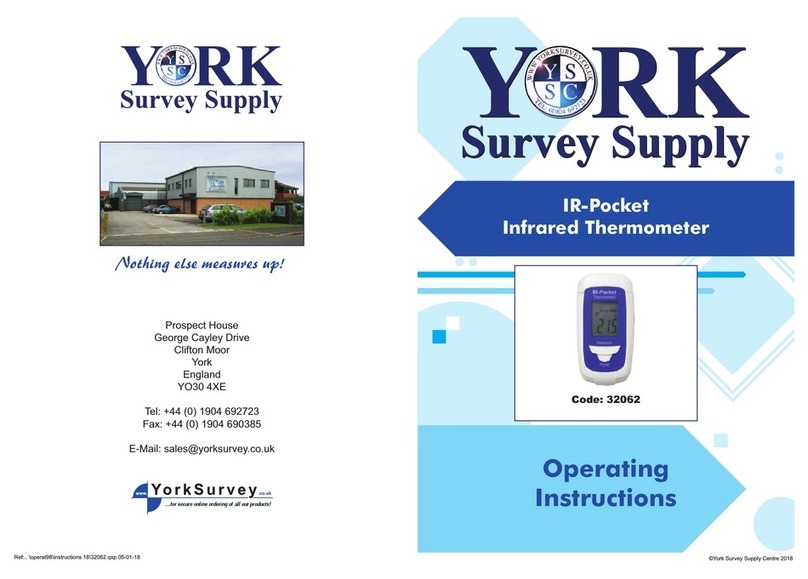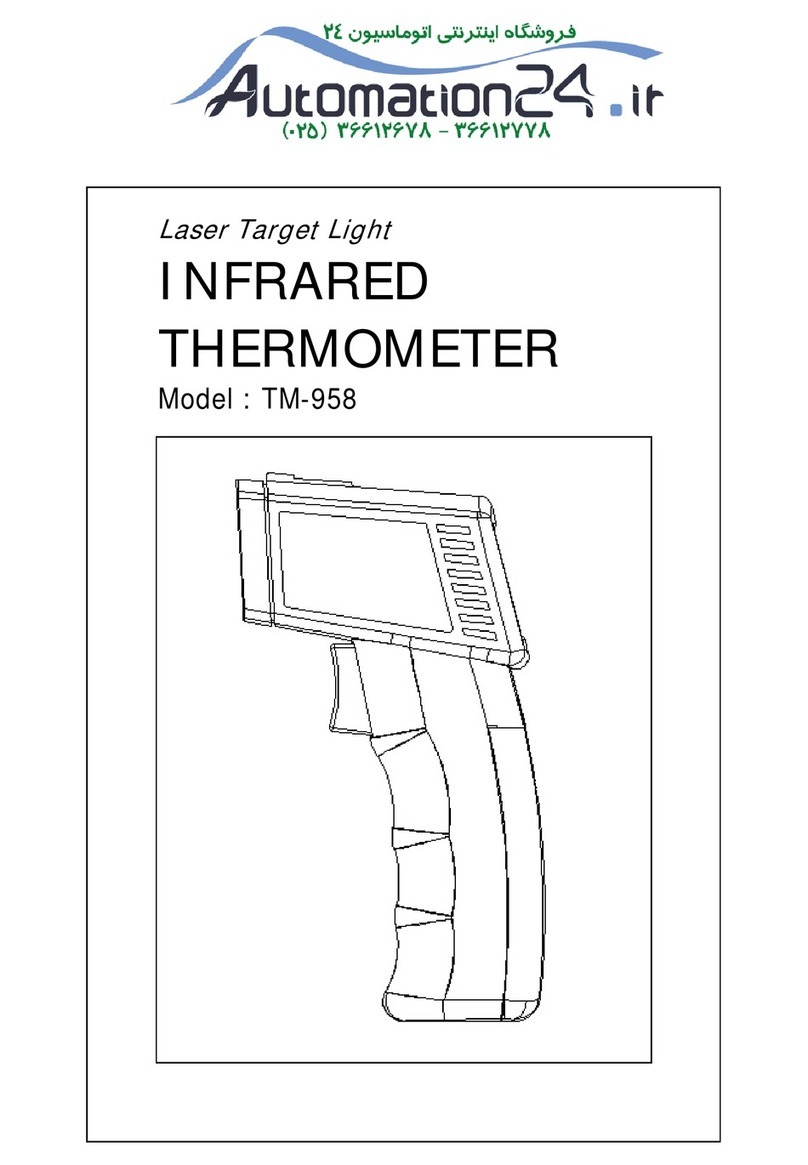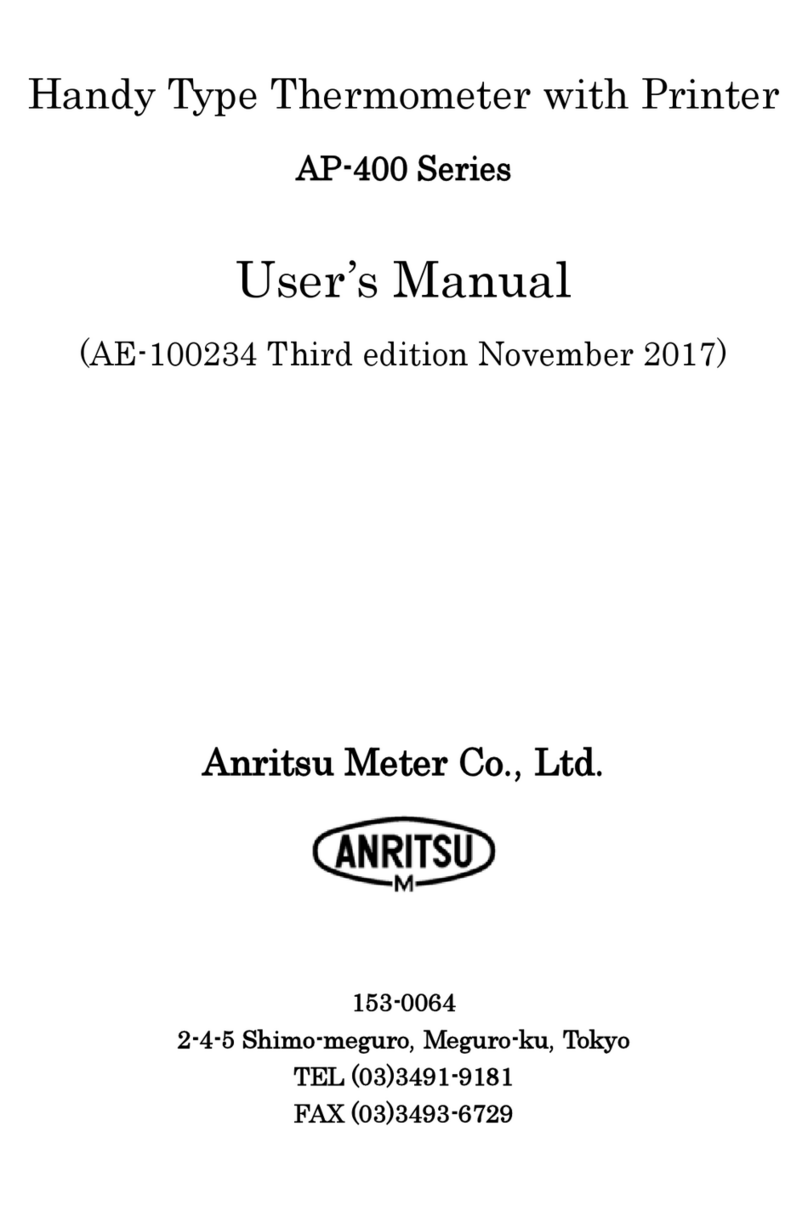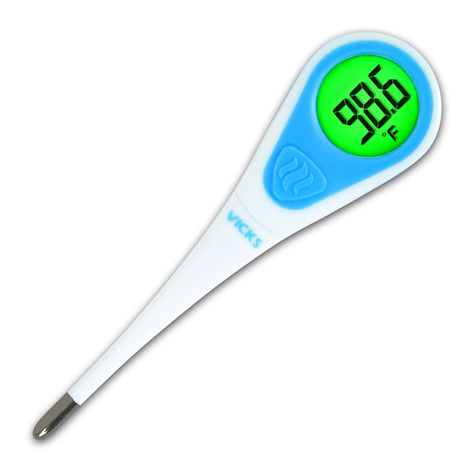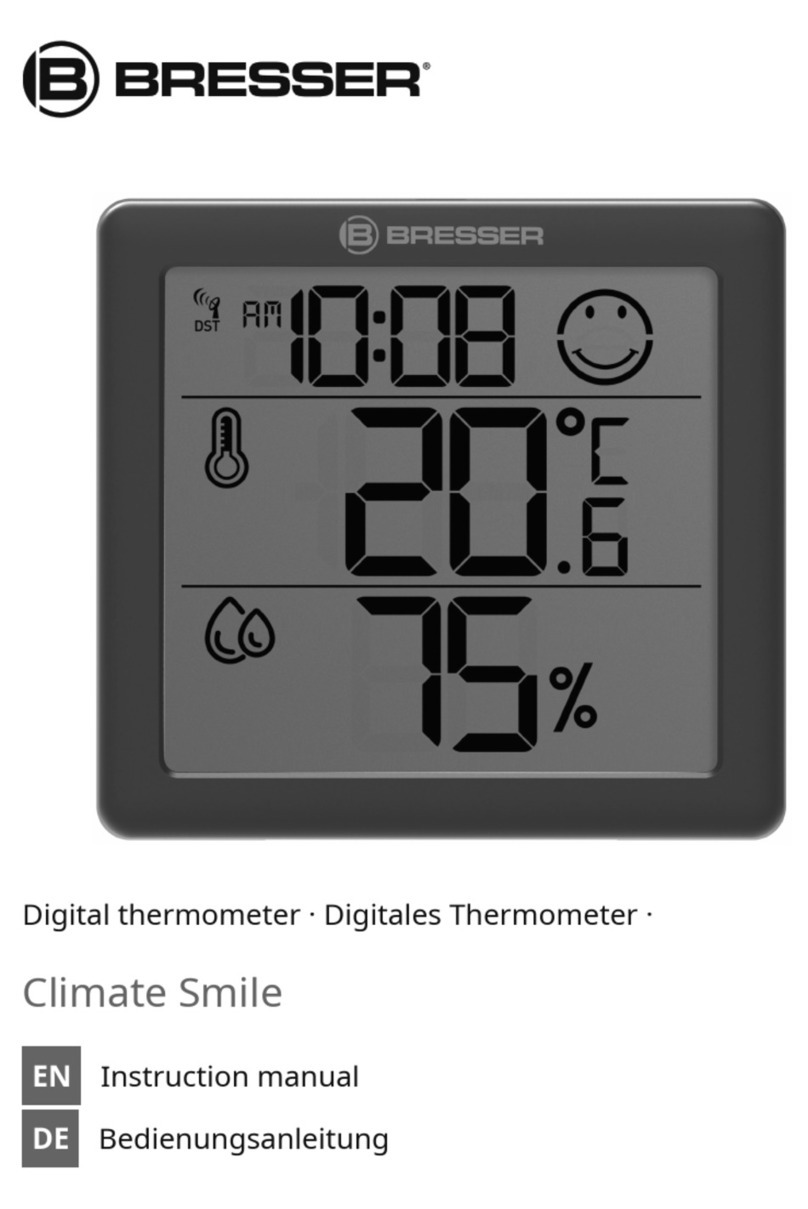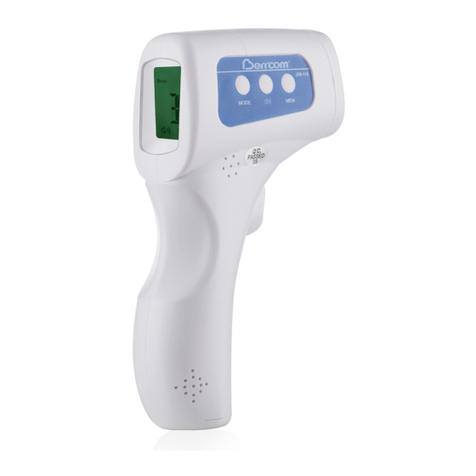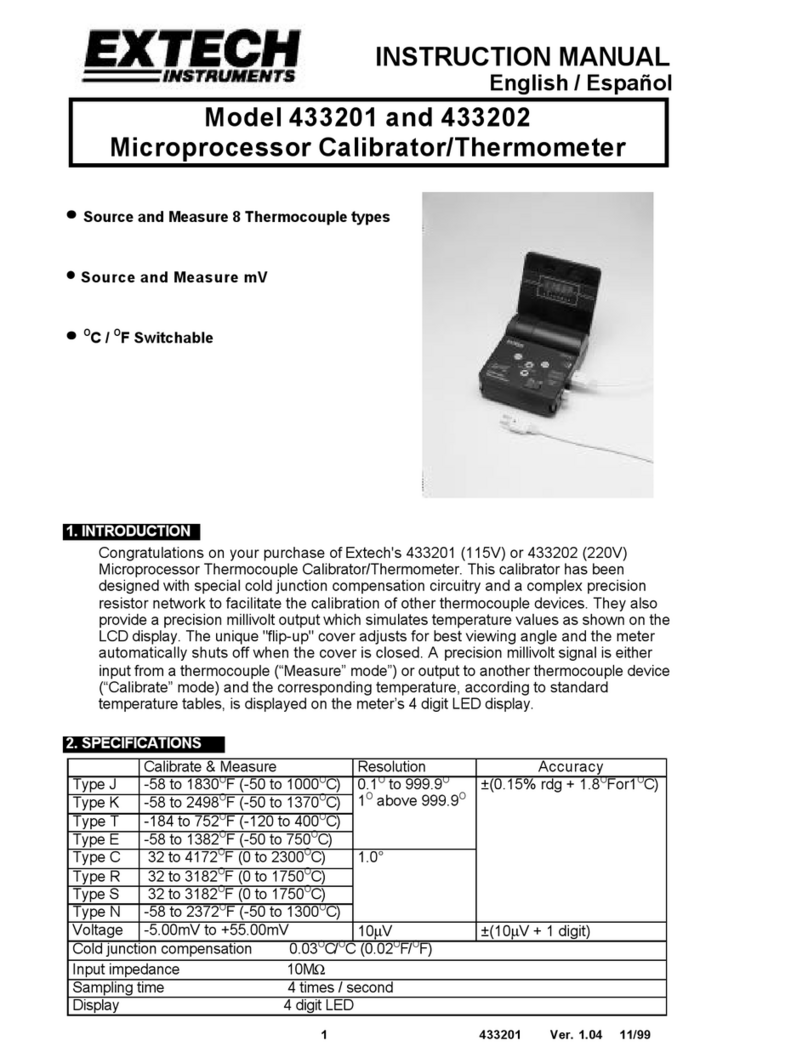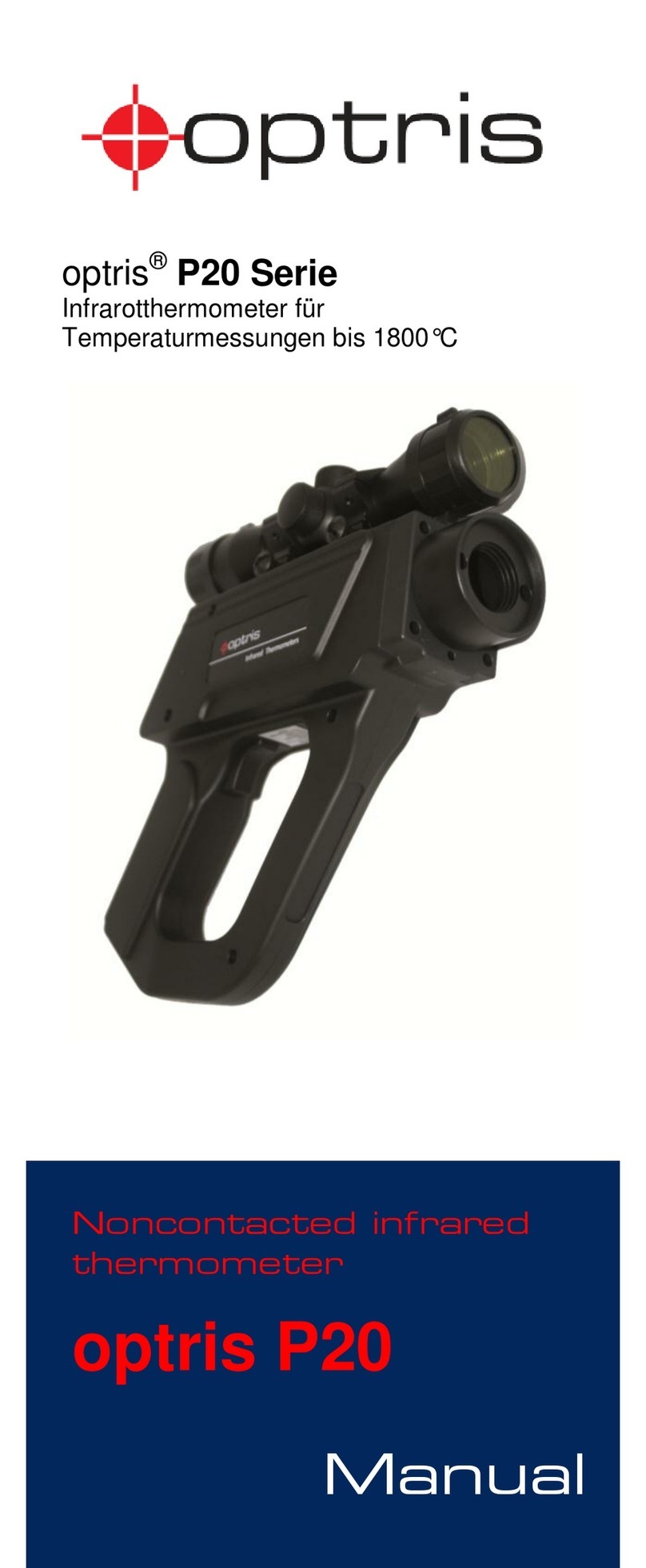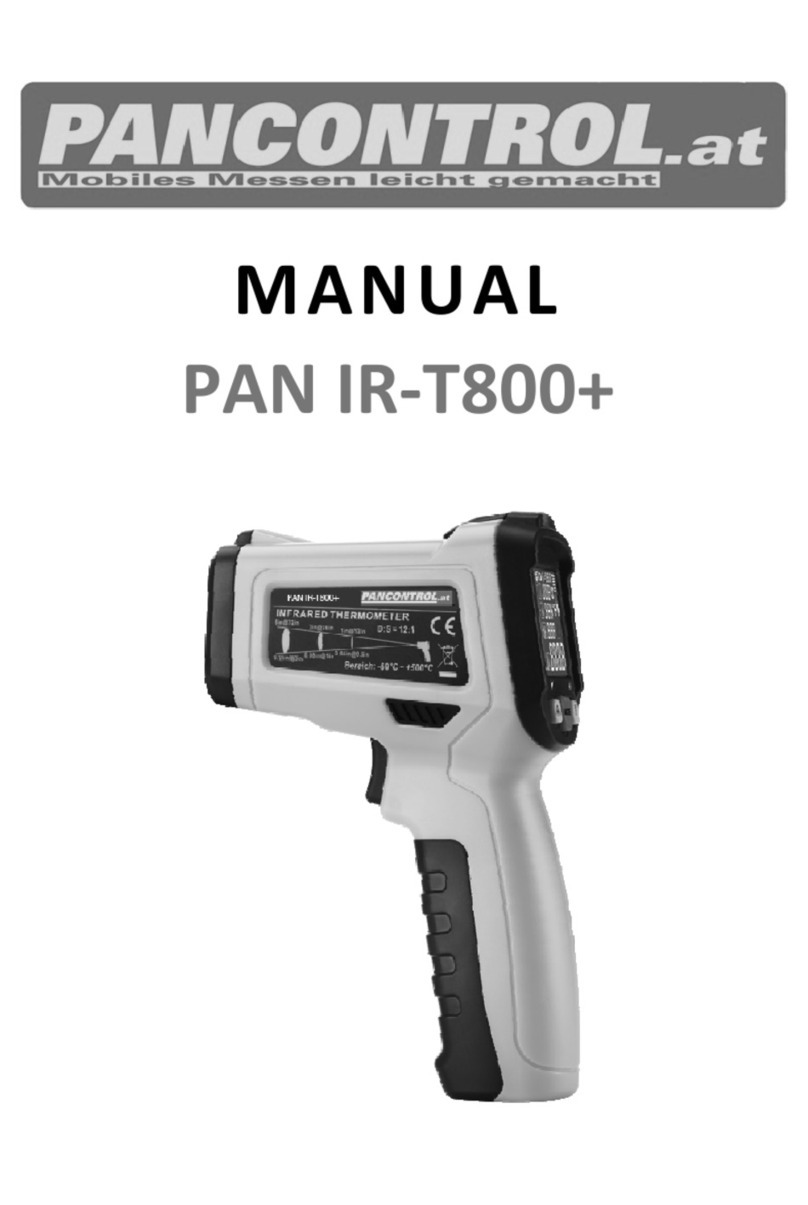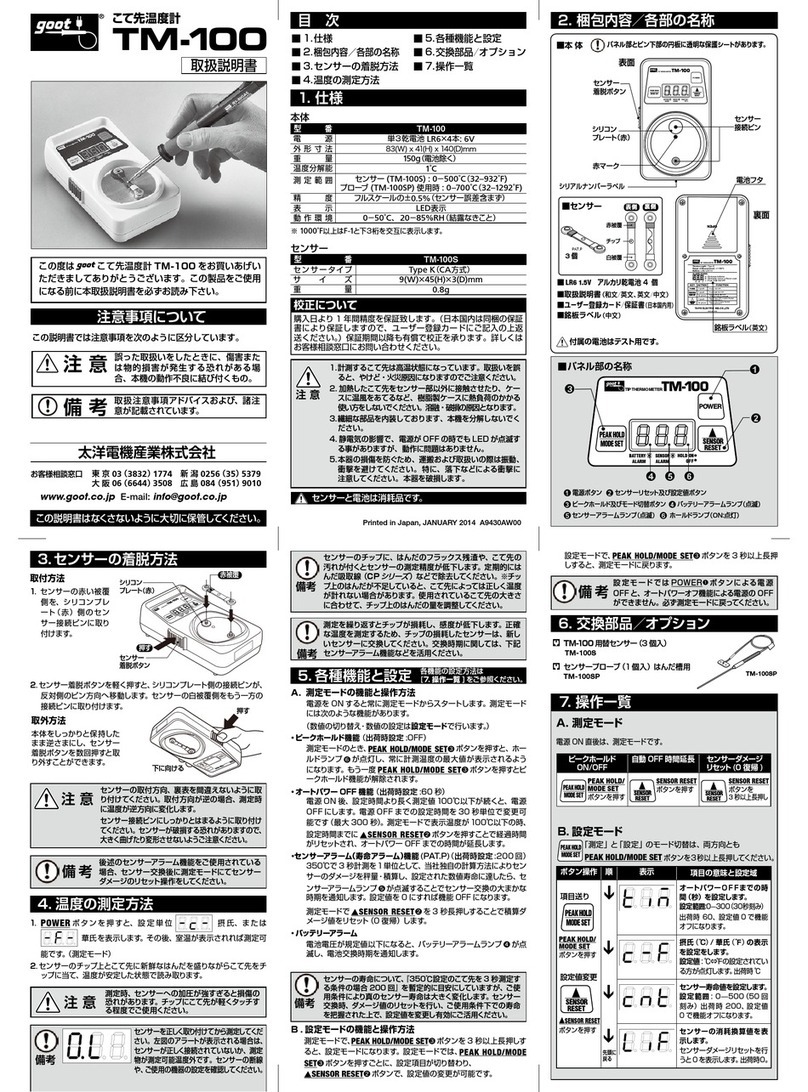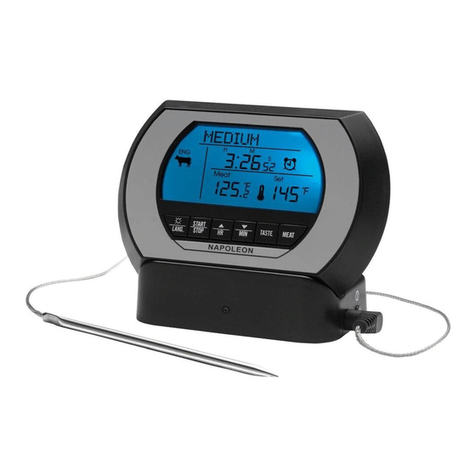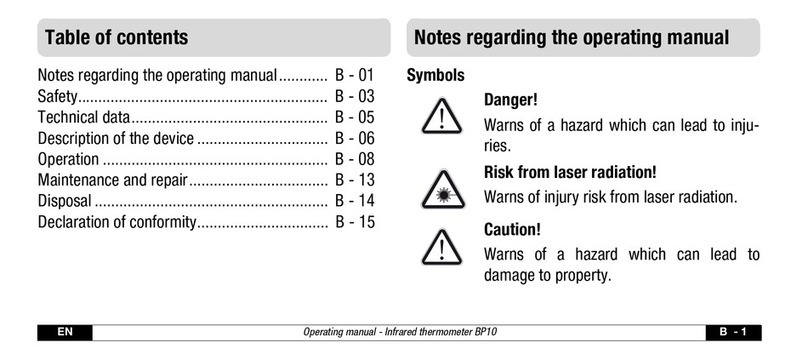Heitronics KT19 II User manual

INFRARED RADIATION
THERMOMETER
KT19 II
Operation Instructions
95582717
46/06/19e (valid from firmware version 4.11 / 5.11)
All rights reserved! The reproduction, transmission or use
of this document or its contents is not permitted without
express written authority. Offenders will be liable for
damages. All rights, including rights created by patent
grant or registration of a utility model or design, are
reserved. Heitronics GmbH reserves the right to make
modifications and improvements in their design without
prior notice.
(c) HEITRONICS Infrarot Messtechnik GmbH
HEITRONICS
Infrarot Messtechnik GmbH
Kreuzberger Ring 40
D-65205 Wiesbaden
Phone: +49 (0)611 97393-0
Fax: +49 (0)611 97393-26
Internet: www.HEITRONICS.com

SAFETY INSTRUCTIONS
Please read carefully the instructions given in TECHNICAL SPECIFICATIONS, especially
the connection and operating instructions as well as the connection instructions and con-
figurations dealt with in SYSTEM START-UP.
ATTENTION
In case of wrong connection,
the device might be destroyed.
The Infrared Radiation Thermometer is an optical measuring instrument. Dirty lenses will
lead to measuring errors. Please pay attention to the instruction given in MAINTENANCE
AND CALIBRATION.
HEITRONICS production meets the latest technical development thereby applying sophis-
ticated components. Nevertheless, functional errors may occur in exceptional cases. The
failure of an instrument may cause a measuring value being issued which seems to be
correct, but is wrong. Please pay attention to the instructions given in MAINTENANCE
AND CALIBRATION.
Only when using a female connector with cable or a dummy plug attached to the plug of
the device - in addition to the equipment sealing - the specified system of protection can
be achieved.
Operation with Laser: Devices completely mounted and equipped with integrated
laser meet the safety requirements of Laser class 2.
Before handling the lens in any way, the voltage supply is to be switched off or the
connecting plug is to be pulled out to ensure that the laser will not switch on automatically.
ATTENTION
The Laser must not be switched on, if the lens
of the Infrared Radiation Thermometer is removed.
The integrated laser cannot operate up to the upper limit of the ambient temperature
of the Infrared Radiation Thermometer (70 °C).
ATTENTION
The Laser will be switched off
at an ambient temperature ≥55 °C
to defend it from destruction.
95582717 SAFETY INSTRUCTIONS KT19 II
03/02/14eHEITRONICS Infrarot Messtechnik GmbH

Erklärung über die Konformität
DECLARATION OF CONFORMITY
Diese Erklärung gilt für folgende Erzeugnisse:
This declaration is valid for the following products:
Geräteart: Infrarot Strahlungspyrometer
Type of instrument: Infrared Radiation Pyrometer
Typenbezeichnung: KT 19 II Serie
Designation of model: KT 19 II Series
Diese Erklärung wird abgegeben durch
This declaration is issued by
HEITRONICS
HEITRONICSHEITRONICS
HEITRONICS Infrarotmesstechnik GmbH
Kreuzberger Ring 40
65205 Wiesbaden, Germany
Hiermit wird bestätigt, dass die Produkte gemäß den Richtlinien des Rates
zur Angleichung der Rechtsvorschriften der Mitgliedsstaaten über die
elektromagnetische Verträglichkeit (89/336/EWG) mit den unten genannten
Normen übereinstimmen:
In accordance with the EU-Directive of Electro-magnetic-compatibility (89/336/EWG)
the manufacturer declare, that the device described above is conform to the
essential requirements of the EU-Directives:
EN 55011 Class B
prEN 50082-2
Wiesbaden, 15. Juli 2002
Wiesbaden, July 15, 2002

PREFACE
The remarkable features of the HEITRONICS devices are a
design suitable for specific application as well as an
uncomplicated operation. Nevertheless, it is recommended to
read the entire instruction manual before putting the
instruments into operation.
Please observe the safety instructions as well as the
particularly emphasized annotations when reading the
pertinent instruction to the operation.
The operating instructions are primarily directed to the user.
They contain the information and instructions necessary to
successfully use the instruments including all options.
If you still have any questions after having read this
instruction manual, please contact us. Our staff will be at your
disposal.
RoHS-CONFORMITY
This product is in conformity with Directive 2011/65/EU of the
European Parliament and of the Council of 8 June 2011 on
the restriction of the use of certain hazardous substances in
electrical and electronic equipment.
LASER-CONFORMITY
The built-in laser complies with:
ISO IEC EN 60825-1
FDA ANSI 21 CFR 1040//Laser Notice No. 50
EU Radiation Safety Optic EU directive 2006/25/EC//
OStrV 2010-07//TROS
The FDA Accession No. is: 1810109-000
95582717 PREFACE KT19 II
04/03/18e HEITRONICS Infrarot Messtechnik GmbH

CONTENTS
SAFETY INSTRUCTIONS
DECLARATION OF CONFORMITY
PREFACE
RoHS-CONFORMITY
LASER-CONFORMITY
CONTENTS......................................................................................................0-1
DATA SHEET...................................................................................................1-1
GENERAL ........................................................................................................2-1
Measuring temperatures using Infrared Radiation Thermometers..............2-1
Infrared Radiation Thermometers for General Application..........................2-2
Infrared Radiation Thermometers for measuring Metals.............................2-3
Infrared Radiation Thermometers for measuring Plastics ...........................2-3
Infrared Radiation Thermometers for measuring Glass..............................2-4
Infrared Radiation Thermometers for measuring Gases.............................2-4
TECHNICAL SPECIFICATIONS ......................................................................3-1
Basics.........................................................................................................3-1
Technical Information “Protective Cooling Jacket”......................................3-3
Assignment for 12-pin connector ................................................................3-5
Assignment for 7-pin connector .................................................................3-6
Temperature resolution
KT 19.01 II / KT 19.02 II............................................................................3-7
KT 19.21 II..................................................................................................3-9
KT 19.23 II / KT 19.24 II..........................................................................3-11
KT 19.25 II................................................................................................3-13
KT 19.41 II / KT 19.42 II..........................................................................3-15
KT 19.43 II................................................................................................3-17
KT 19.45 II................................................................................................3-19
KT 19.61 II / KT 19.62 II..........................................................................3-21
KT 19.63 II................................................................................................3-23
KT 19.69 II................................................................................................3-25
KT 19.81 II / KT 19.82 II..........................................................................3-27
KT 19.83 II / KT 19.85 II..........................................................................3-29
0-1
95582717 CONTENTS KT 19 II
17/03/18e HEITRONICS Infrarot Messtechnik GmbH

START-UP........................................................................................................ 4-1
Mounting..................................................................................................... 4-1
Mounting KT 19 II / Protective Cooling Jacket ............................................4-1
Mounting KT 19II using Adapter B2-B7-B4 ................................................. 4-2
Connecting and Running The Nitrogen Purge (Option)............................... 4-3
Electrical connection ...................................................................................4-4
Assignment for 12-pin connector ................................................................4-4
Assignment for 7-pin connector ..................................................................4-4
Optical sighting ...........................................................................................4-5
Aiming via through-the-lens sighting ........................................................... 4-5
Aiming via focus laser ................................................................................. 4-6
Aiming via pilot laser ................................................................................... 4-6
Controlling anti-glare filter in optical view finder ..........................................4-6
OPERATION AND APPLICATION ............................................................. 5-1
Communication via interface.................................................................. 5-1
Preparing the instrument for the operation with RS232C interface ...... 5-1
Control of communication..................................................................... 5-3
Description of commands..................................................................... 5-3
Operation and configuration via keypad................................................. 5-3
Functionality of main display ................................................................ 5-4
Function of keyboard............................................................................ 5-4
Menu Overview .................................................................................... 5-5
Code Setting ........................................................................................ 5-6
Interrogation of parameters.................................................................. 5-7
Correction of ambient effects ............................................................... 5-8
Show and change response time....................................................... 5-15
Configuration of memory function ...................................................... 5-16
Alarms................................................................................................ 5-24
Anti-glare filter .................................................................................... 5-28
Laser .................................................................................................. 5-29
Change temperature unit ................................................................... 5-32
Change analog input .......................................................................... 5-33
Change analog output........................................................................ 5-37
Digital input ........................................................................................ 5-42
Configuration of digital outputs........................................................... 5-44
Configuring serial interface................................................................. 5-49
Calibration and adjustment................................................................. 5-50
Setting operating mode (Scanner Mode)............................................ 5-51
Contrast of the graphic display........................................................... 5-52
Viewfinder – display brightness.......................................................... 5-53
Resetting to factory defaults............................................................... 5-54
Check routines..................................................................................... 5-55
Error detection via interface ............................................................... 5-55
Error detection via display .................................................................. 5-55
Error detection via analog output ....................................................... 5-56
. Monitoring the instrument function during operation ............................ 5-56
0-2
95582717 CONTENTS KT 19 II
19/06/19e HEITRONICS Infrarot Messtechnik GmbH

MAINTENANCE AND CALIBRATION .............................................................6-1
General information ....................................................................................6-1
Cleaning the lens ........................................................................................6-1
Checking the display accuracy.................................................................... 6-1
FIGURES AND TABLES
Diagram "Cooling with water"...................................................................... 3-4
Diagram "Cooling with air" .......................................................................... 3-4
Mounting KT 19 II / Protective Cooling Jacket ............................................4-1
Rear view KT 19 II ...................................................................................... 5-1
Operation via keyboard............................................................................... 5-5
Code setting................................................................................................ 5-5
Connection of a module with PT100 to KT 19 II........................................5-14
Alarm contacts "Pin assignment" .............................................................. 5-15
Alarm contacts "Function"......................................................................... 5-16
Spectral emissivity of various materials ......................................................7-2
Total emissivity of some materials at 20 °C ................................................ 7-2
Spectral / total emissivity of some metals ...................................................7-3
Emissivity of foils ........................................................................................ 7-4
Spectral emissivity of Infrared Radiation Thermometers and
transmission curves of various synthetic materials .....................................7-5
Spectral emissivity, transmissivity and reflectivity of glass..........................7-6
Dimensions KT 19 II ................................................................................... 7-7
Dimensions KT 19 II with Cooling and Protective Jacket ............................ 7-8
Field of view................................................................................................7-9
Spectral response (illustrated in a diagram)............................................ 7-10ff
TABLES
Minimum temperature of the coolant...........................................................3-3
Assignment for 12-pin connector ................................................................ 3-5
Assignment for 7-pin connector ..................................................................3-6
"Temperature resolution" .......................................................................... 3-7ff
“Communication" ........................................................................................ 5-3
Alarm contacts .......................................................................................... 5-15
Minimum temperatures ............................................................................... 6-1
WARRANTY CONDITIONS
SERVICE ADDRESS
0-3
95582717 CONTENTS KT 19 II
19/06/19e HEITRONICS Infrarot Messtechnik GmbH

1 DATA SHEET
Type..........................................................................................................
Serial No.
.......................................................
Spectral response
.......................................................
Temperature range
……………………………………
Calibration factor
........................................................
Lens................................................
Spacer ............................................
Detector..........................................
Digital Interface...............................
Options
.....................................................................................................................................
.....................................................................................................................................
Accessories
.....................................................................................................................................
.....................................................................................................................................
Code............................................................................................................................
Further data.................................................................................................................
.....................................................................................................................................
Hereby it is confirmed that the Infrared Radiation Thermometer specified above
conforms to the data indicated in the specifications.
Tester: Wiesbaden,
1-1
95582717 DATA SHEET KT19 II
04/01/15e HEITRONICS Infrarot Messtechnik GmbH

2 GENERAL
2.1 Measuring temperatures using Infrared Radiation Thermometers
Above a temperature of absolute zero, which is approx. - 273 °C or 0 K, all bodies
emit electromagnetic radiation, the wavelength and density of which depend on the
temperature. Up to a temperature of approx. 600 °C, the wavelength of the radiation
can be found exclusively within the infrared range (thermal radiation). It is only at
higher temperatures where part of this radiation is emitted in the form of visible light.
The radiation emitted by the body (radiation density) also depends on the surface of
the individual body. At a fixed temperature, the maximum radiation density is emitted
by a "blackbody" source of radiation. All real bodies only emit a fraction of this radia-
tion density at the same temperature. The ratio of this fractional part to the maximum
radiation density is called the emissivity ε. Naturally, the emissivity is always < 1. It
depends on the nature of the surface of the material, on the material itself and on the
wavelength. If the emissivity is known, the temperature of the object can be deter-
mined by measuring the infrared radiation emitted by the very object.
Devices used to measure this kind of radiation are called Infrared Radiation Ther-
mometers.
As the measurement is effected without the Infrared Radiation Thermometer being in
contact with the object, no distortion of the temperature field due to heat dissipation
need to be feared, as is the case, e.g., with probe-type thermometers.
The Infrared Radiation Thermometer is a measuring transducer, which receives the
infrared radiation emitted by the measuring object itself and transforms it into a
standardized output signal.
All optic and electronic components are located in a small housing of a solid con-
struction, which is made from die-cast metal so that the installation of a Infrared Ra-
diation Thermometer is possible even in narrow spaces.
By selecting a number of various lenses and detectors, it is possible to generously
modify the measuring field, if the measuring distance is given.
For the application of the Infrared Radiation Thermometer under high ambient tem-
perature, water-cooling, air purge fittings and vacuum tight lenses can be delivered
as accessories.
2-1
95582717 GENERAL KT19 II
04/02/14e HEITRONICS Infrarot Messtechnik GmbH

2.2 Infrared Radiation Thermometers for GENERAL APPLICATION
The Infrared Radiation Thermometers series KT19.81 II, KT19.82 II, KT19.83 II are
used to measure surface temperatures within a temperature range of - 50 to
1000 °C. The spectral sensitivity can be found within the range of the atmospheric
window, which is between 8 and 14 µm. As the atmospheric transmissivity is very
high in this spectral range, no weakening of the infrared radiation due to CO2or to
water vapor contained in the air is to be expected.
To meet especially high requirements as to the transmission of the atmosphere (as it
is a case e.g. when carrying out meteorological measurements) Infrared Radiation
Thermometer KT19.85 II is suitable.
The KT19.81 II, KT19.82 II, KT 19.83 II can be employed in the measuring of tem-
peratures during the production and processing of plastics, rubber, paper, textiles,
paint, ceramics etc. The emissivity of various metals is shown in figure 10
(Ch. 7: Figures).
The devices can also be used to measure the temperature of objects exposed to in-
frared radiation, since the radiation maximum of infrared radiators is within the range
of shorter wavelengths, which do not cause the Infrared Radiation Thermometers
KT 19.81 II, KT19.82 II, KT19.83 II to react.
The Infrared Radiation Thermometer KT19.81 II is used in the spectral range of 8 to
10 μm. Besides being used for large-surface measurement, this Infrared Radiation
Thermometer type is also suitable for measuring thick foils.
The Infrared Radiation Thermometer KT19.82 II is applied for the standard measur-
ing range of 8 to 14 µm thereby guaranteeing a good signal resolution.
2-2
95582717 GENERAL KT19 II
05/06/18e HEITRONICS Infrarot Messtechnik GmbH

2.3. Infrared Radiation Thermometer for measuring METALS
The spectral emissivity of the Infrared Radiation Thermometer KT19.01 II, KT19.02 II
is 2 to 2.7 µm and 2 to 4.5 µm. Within this spectral range, metals and metal-oxides
show a relatively high spectral emissivity. This is why the device is particularly well
suited to measure the temperatures of these materials. Since the atmospheric trans-
missivity is high within the spectral range of 2 to 2.7 µm, distortions of the measured
value owing to absorption of water vapor and CO2in the air can be ignored
(Chap. 7: FIGURES, Fig. 11).
The Infrared Radiation Thermometer type KT19.01 II is used for measuring tempera-
tures from 300 °C onwards, the Infrared Radiation Thermometer type KT19.02 II is
suitable for measuring temperatures from 200 °C onwards. Temperatures from
500 °C respectively 700 °C onwards are preferably measured by means of
HEITRONICS Series CT18 or KT18RD.
2.4 Infrared Radiation Thermometers for measuring PLASTICS
These types of Infrared Radiation Thermometers are employed for the measuring of
surface temperatures of plastics within a temperature range of 0 to 600 °C.
These Infrared Radiation Thermometers are equipped with narrow-band infrared fil-
ters.
KT19.21 II measures radiation at 3.43 µm,
KT19.23 II measures radiation at 6.8 µm,
KT19.24 II measures radiation at 7.93 µm and
KT19.25 II measures radiation at 8.05 µm.
Within these spectral ranges, virtually all synthetic materials have strong absorption
bands so that even thin foils show high emissivity.
The Infrared Radiation Thermometer KT19.21 II is suitable for most foils from 100 °C
onwards.
The Infrared Radiation Thermometer KT19.23 II measures thin foils made from poly-
ethylene, polypropylene, polyisobutane, polynitrile, polystyrene and similar materials
from 0 °C onwards.
The Infrared Radiation Thermometer KT19.24 II and KT19.25 II measure thin foils
polyester as well as foils made from
- acrylic,
- cellulose,
- fluorine compounds,
- polycarbonate,
- polyamide,
- polyurethane,
- polyvinylchloride
and similar materials after analysis from 0 °C onwards.
2-3
95582717 GENERAL KT19 II
05/06/18e HEITRONICS Infrarot Messtechnik GmbH

2.5 Infrared Radiation Thermometersfor measuring GLASS
KT19.42 II is suitable for measuring glass and quartz. The spectral sensitivity is
4.9 to 5.5 µm. The emissivity of glass is very similar to the emissivity of a blackbody
radiator within this spectral range. Furthermore, this spectral range eliminates any
disturbing influences resulting from the strong absorption bands of water vapor at
6.2 µm.
The Infrared Radiation Thermometers KT19.01 II and KT19.41 II are not measuring
the surface but the average value of temperatures up to a certain penetration depth
(glass volume). The lower limits are 300 °C for KT19.01 II and 400 °C for KT19.41 II.
The types KT19.42 II and KT19.43 II measure the surface temperature from 100 °C
respectively from 0 °C onwards.
2.6 Infrared Radiation Thermometer for measuring GASES
By means of narrow-band filters, the selective measurement of temperature of cer-
tain gases is possible. A rather long response time is to be chosen since the radiation
energy is very low.
KT19.21 II measures hydrocarbon from 100 °C onwards.
The Infrared Radiation Thermometer KT19.61 II measures carbon dioxide,
KT19.62 II measures materials within the absorption range of carbon dioxide and
carbon monoxide,
KT19.63 II measures carbon monoxide selectively,
KT19.69 II has been especially developed for determination of combustion tempera-
tures from 400 °C onwards.
Using KT19.41 II, objects can be measured through gases and flames from 400 °C
onwards.
2-4
95582717 GENERAL KT19 II
05/06/18e HEITRONICS Infrarot Messtechnik GmbH

3-
1
95582717 TECHNICAL SPECIFICATIONS KT19 II
13/02/14e HEITRONICS Infrarot Messtechnik GmbH
3 TECHNICAL SPECIFICATIONS
3.1 Basic Data
Spectral sensitivity: DATA SHEET (Ch. 1)
Temperature measuring range: DATA SHEET (Ch. 1)
Temperature resolution: Tables (Page 3-7ff)
Accuracy (provided that the emissivity has been correctly set, after a warm-up period of 15 min):
± 0.5 °C plus 0.7 % of the temperature difference
between the housing containing the measuring in-
struments and the object to be measured
or: value of temperature resolution.
The higher value shall prevail.
Long-time stability: better than 0.1 ‰of the absolute measuring tem-
perature in Kelvin/month
Lens used: DATA SHEET (Ch. 1)
Possible lenses: OPTIONS AND ACCESSORIES
Target diameter (95 %): The target diameter depends on the lens and the
detector used in each individual case. When short-
focus lenses are used, the distance within which
the minimum measuring field can be found varies
by ± 4%
Field of view: Marking the field of view is carried out by means of
different accessories OPTICAL ADJUSTMENT
Radiation detector: HEITRONICS pyroelectric detector
Permissible ambient temperature: - 20 °C ... 70 °C
For higher ambient temperatures, cooling and
protecting jackets are available
Technical Information (below)
Storage temperature: - 20 °C … + 70 °C
Weight: approx. 2.35 kg
Dimensions: ILLUSTRATIONS: Fig. 15 and 16
Operating voltages: AC: 24 V ± 10 %, 48 ... 400 Hz
DC: 20 ... 30 V
Power consumption: ≤ 4 W
Type of protection: IP65 (NEMA4 equivalent)

Analog output: possible signal outputs (variable by programming)
0 … 20 mA, 4 … 20 mA
0 … 1 V, 0 … 10 V
Lower temperature value (T.low): minimum temp. value for analog signal
Upper temperature value (T.end): maximum temp. value for analog output
Minimum temperature difference: depends on final temperature (T.end)
The following values will result:
Final temperature
Minimum temperature
difference
≤ 150 °C
50 °C
≤ 200 °C
100 °C
≤ 1000 °C
200 °C
> 1000 °C
400 °C
Resolution of the analog output: 12 bit
Digital interface V24 (RS232C): 9.6 … 115.2 kBaud
Response time (90 %): variable by programming
0.005; 0.01; 0.03; 0.1; 0.3; 1; 3; 10; 30; 60; 120;
240; 360; 480; 600 s
Protection against oscillation: DIN 40046 Bl. 8; test: Fc
vibration strength: A B1 E
frequency range: 10 to 55 Hz
amplitude: ± 0.2 mm
duration of test/position: 30 min
Connector type: Miniature circular connector,
made by Franz Binder GmbH,
type 99-5630-15-12, series 423, 12 pin and
type 99-5626-15-07, series 423, 7 pin
Alarm contacts: relay contacts (normally open)
maximum load: 10 VA
load: voltage ≤ 48 V, current ≤ 0.5 A
Options:
Thermal switch: switching temperature: > 70 °C
load:voltage: ≤ 48 V, current ≤ 0.5 A
Laser: The integrated laser can not operate up to the
upper limit of the ambient temperature of the
Infrared Radiation Thermometer
Safety Instructions
Laser-Conformity
Laser
type Protection
class Output Wave-
length Form Diameter
Max.
ambient
temperature
Pilot
laser
2 < 1 mW 650 nm round beam Ø 3 mm @ 1 m distance 55.0 °C
Focus
laser
2 < 1 mW 650 nm
cross lines
with centering circle
adapted to field of view
in the focus distance
55.0 °C
3-2
95582717 TECHNICAL SPECIFICATIONS KT19 II
15/03/18e HEITRONICS Infrarot Messtechnik GmbH

Technical Information
Protective Cooling Jacket
The HEITRONICS Infrared Radiation Thermometers can be operated at an environmental
temperature of up to 60 °C/ 70 °C 1without any additional coolants. If the environmental
temperatures are higher than that mentioned above, cooling fittings can be used.
Basically, the protective cooling jacket can be cooled with air or water. The possible
maximum environmental temperatures are higher for water cooling than for air cooling
(individual data sheets).
If the cooling process is too strong, i.e. if the cooling air / cooling water is too cold, this
may result in condensate at the protective cooling jacket as soon as cooling medium
falls below the dew point. To prevent this from occurring, the cooling air / cooling water
must have a minimum temperature as a function of the relative humidity.
The following table specifies the minimum temperature of the cooling air / cooling water
as a function of the environmental temperature and the relative humidity of the environ-
mental air.
Minimum temperature of the cooling air / cooling water
Relative air humidity (of the environmental air)
Environmental
air temperature
/°C
2%
4%
10%
20%
30%
50%
70%
30,0
5,0 5,0 5,0 6,0 11,0 19,0 25,0 °C
40,0 5,0 5,0 5,0 13,0 20,0 28,0 34,0 °C
50,0 5,0 5,0 10,0 21,0 28,0 38,0 45,0 °C
60,0
5,0
5,0
18,0
28,0
38,0
47,0
54,0
°C
70,0
5,0 9,0 24,0 38,0 45,0 57,0 nm
°C
80,0 5,0 15,0 32,0 45,0 55,0 nm nm °C
90,0 10,0 21,0 38,0 52,0 nm nm nm °C
>100,0
15,0
27,0
45,0
60,0
nm
nm
nm
°C
Legend: nm * Operation not possible since the minimum temperature is above 60°C
Table: Minimum temperature of the coolant
1 Depends on Infrared Radiation Thermometer type 3-3
95582717 TECHNICAL SPECIFICATIONS KT19 II
14/01/15e HEITRONICS Infrarot Messtechnik GmbH

3-
4
95582717 TECHNICAL SPECIFICATIONS KT19 II
13/02/14e HEITRONICS Infrarot Messtechnik GmbH
240
250
260
270
280
290
300
310
320
330
340
0,4 0,6 0,8 1 1,2 1,4 1,6
15°C
20°C
25°C
Cooling with Water or Air
Two operation modes allow cooling with water or air.
Cooling with Water:
The graph below shows the maximum possible ambient temperatures for the given
flow rates of water.
Max. permissible ambient temperature in °C
Water flow rate in liter/min (1 l/min = 16 gal./h)
Parameter: Water temperature 15/20/25 °C
Max. recommended water pressure: 6 bar (87 psi)

Assignment for 12-pin connector
ATTENTION
In case of wrong connection,
The device might be destroyed.
(1): Hardware-Programming see data sheet page 1-1
(2): Configurable from Firmware 3.93
12-pin plug connector 12-pin socket-outlet
Cores
color
Code
DIN IEC 757
Plug-in
contacts
RS232
9 pin
RS232
25 pin
red RD A DTR 6 6
white
WH B − external ambient temperature
green/white
alternative:
grey/pink
colorless
GNWH
GYPK
colorless
C alarm contact 2 (high) (2)
grey GY D alarm contact 1 (low) (2)
digital input (DI) (1)
yellow YE E + external ambient temperature
brown/white
alternative:
red/blue
orange
BNWH
RDBU
OR
F alarm contact 1 (low) (2)
digital input-zero (Gnd) (1)
pink PK G RXD 3 2
violet VT H TXD 2 3
blue BU J RTS 8 5
black BK K − data ground 5 7
brown BN L alarm contact 2 (high) (2)
green GN M CTS 7 4
3-5
95582717 TECHNICAL SPECIFICATIONS KT19 II
14/01/15e HEITRONICS Infrarot Messtechnik GmbH

Assignment for 7-pin connector
ATTENTION
When connecting the Infrared Radiation Thermometer to the Power Supply
Unit T24 please note the connection conditions in the manual.
Cores
color
Code
DIN IEC 757
Plug-in
contacts
brown
BN
4
+ supply voltage
(direct or alternating voltage)
−
white
WH
2
yellow
YE
5
+
analog output
−
green
GN
1
blue *)
BU
3
housing ground
pink
PK
6
thermal switch
grey
GY
7
thermal switch
*) PVC cable: seven core
Silicone cable: six-core with shielding
Blue shielding insulation at cable end.
7-pin plug connector 7-pin socket-outlet
The load resistors for the analog outputs are:
►for voltage output 0 to 1 V ≥ 50 kOhm, ►for voltage output 0 to 10 V ≥ 500 kOhm,
►for current output 0 to 20 mA ≤ 550 Ohm ►for current output 4 to 20 mA ≤ 550 Ohm
For the signal evaluation, differential inputs are recommended.
3-6
95582717 TECHNICAL SPECIFICATIONS KT19 II
14/01/15e HEITRONICS Infrarot Messtechnik GmbH

95582716 TECHNISCHE DATEN / TECHNICAL SPECIFICATIONS KT19 II
11/01/14def HEITRONICS Infrarot Messtechnik GmbH
3-7
Temperaturauflösung / Temperature resolution KT19.01 II / KT19.02 II
Temperaturauflösung (NET) in ± K (bei Emissionsgrad = 1; für Objektive mit 39 mm Durchmesser).
Bei Verwendung von Objektiven mit 26 mm Durchmesser sowie von Objektiven mit 39 mm Durchmesser mit
Zwischenring wird die Temperaturauflösung (NET) doppelt so groß.
Temperature resolution (NET) in ± K (emissivity = 1; for lenses with a diameter of 39 mm).
When using lenses with a diameter of 26 mm as well as lenses with a diameter of 39 mm and spacer, the
temperature resolution (NET) will be doubled.
Strahler-
temperatur
Radiation
temperature
KT 19.01 II KT 19.02 II
Einstell-
zeit
Response
time
Detektortyp
Detector type Einstell-
zeit
Response
time
Detektortyp
Detector type
A
B
C
G
A
B
C
G
200 °C
5 ms ** ** ** ** 5 ms 3.35 12.35 ** **
10 ms ** ** ** ** 10 ms 2.70 10.00 ** **
30 ms 12.60 ** ** ** 30 ms 0.70 2.55 6.25 **
100 ms 5.15 19.10 ** ** 100 ms 0.30 1.05 2.55 8.55
300 ms 3.45 12.75 ** ** 300 ms 0.20 0.70 1.70 5.70
1 s 1.45 5.30 12.90 ** 1 s 0.10 0.30 0.70 2.35
3 s 0.85 3.20 7.75 ** 3 s 0.05 0.20 0.45 1.40
10 s 0.55 2.10 5.15 17.20 10 s 0.05 0.10 0.30 0.95
300 °C
5 ms 9.80 ** ** ** 5 ms 1.00 3.60 8.70 **
10 ms 7.95 ** ** ** 10 ms 0.80 2.90 7.05 **
30 ms 2.05 7.55 18.35 ** 30 ms 0.25 0.75 1.80 6.05
100 ms 0.85 3.10 7.50 ** 100 ms 0.10 0.30 0.75 2.45
300 ms 0.55 2.05 5.00 16.70 300 ms 0.05 0.20 0.50 1.65
1 s 0.25 0.85 2.10 6.95 1 s 0.05 0.10 0.20 0.70
3 s 0.15 0.50 1.25 4.15 3 s 0.05 0.05 0.10 0.40
10 s 0.10 0.35 0.85 2.80 10 s 0.05 0.05 0.10 0.25
500 °C
5 ms 1.10 3.90 9.45 ** 5 ms 0.55 0.95 1.95 6.35
10 ms 0.85 3.15 7.65 ** 10 ms 0.30 0.70 1.55 5.15
30 ms 0.25 0.80 1.95 6.55 30 ms 0.20 0.25 0.45 1.35
100 ms 0.10 0.35 0.80 2.65 100 ms 0.05 0.10 0.15 0.55
300 ms 0.05 0.20 0.55 1.80 300 ms 0.05 0.05 0.10 0.35
1 s 0.05 0.10 0.20 0.75 1 s 0.05 0.05 0.05 0.15
3 s 0.05 0.05 0.15 0.45 3 s 0.05 0.05 0.05 0.10
10 s 0.05 0.05 0.10 0.30 10 s 0.05 0.05 0.05 0.05
700 °C
5 ms 0.70 1.30 2.85 9.25 5 ms 0.75 0.85 1.10 2.65
10 ms 0.40 0.95 2.25 7.50 10 ms 0.40 0.45 0.70 2.10
30 ms 0.25 0.35 0.65 1.95 30 ms 0.30 0.30 0.35 0.60
100 ms 0.05 0.10 0.25 0.80 100 ms 0.10 0.10 0.10 0.25
300 ms 0.05 0.10 0.15 0.55 300 ms 0.05 0.05 0.05 0.15
1 s 0.05 0.05 0.05 0.20 1 s 0.05 0.05 0.05 0.05
3 s 0.05 0.05 0.05 0.15 3 s 0.05 0.05 0.05 0.05
10 s 0.05 0.05 0.05 0.10 10 s 0.05 0.05 0.05 0.05
1000 °C
5 ms 1.05 1.10 1.40 3.40 5 ms 1.20 1.20 1.25 1.65
10 ms 0.50 0.60 0.90 2.65 10 ms 0.60 0.60 0.65 1.10
30 ms 0.40 0.40 0.45 0.80 30 ms 0.50 0.50 0.50 0.55
100 ms 0.10 0.10 0.15 0.30 100 ms 0.15 0.15 0.15 0.15
300 ms 0.10 0.10 0.10 0.20 300 ms 0.10 0.10 0.10 0.10
1 s 0.05 0.05 0.05 0.10 1 s 0.05 0.05 0.05 0.05
3 s 0.05 0.05 0.05 0.05 3 s 0.05 0.05 0.05 0.05
10 s 0.05 0.05 0.05 0.05 10 s 0.05 0.05 0.05 0.05
** = Wert / Value > 20 °C. Diese Einstellung wird nicht empfohlen. / This setting is not recommended.

95582716 TECHNISCHE DATEN / TECHNICAL SPECIFICATIONS KT19 II
11/01/14def HEITRONICS Infrarot Messtechnik GmbH
3-8
Temperaturauflösung / Temperature resolution
Temperaturauflösung (NET) in ± K (bei Emissionsgrad = 1; für Objektive mit 39 mm Durchmesser).
Bei Verwendung von Objektiven mit 26 mm Durchmesser sowie von Objektiven mit 39 mm Durchmesser mit
Zwischenring wird die Temperaturauflösung (NET) doppelt so groß.
Temperature resolution (NET) in ± K (emissivity = 1; for lenses with a diameter of 39 mm).
When using lenses with a diameter of 26 mm as well as lenses with a diameter of 39 mm and spacer, the
temperature resolution (NET) will be doubled.
Legend Table Légende Tableau
Temperature resolution (NET) in ± K
(emissivity = 1; for lenses with a diameter of
39 mm).
Résolution de température (NET) ± K
(émissivité = 1; pour objectifs avec un
diamètre de 39 mm).
When using lenses with a diameter of 26 mm
as well as lenses with a diameter of 39 mm
and spacer, the temperature resolution (NET)
will be doubled.
Si des objectifs avec un diamètre de 26 mm
ou des objectifs avec un diamètre de 39 mm
et bague est utilisé, la résolution de tempéra-
ture (NET) se double.
** = Value > 20 °C.
This setting is not recommended. ** = Valeur > 20 °C.
Cette configuration n'est pas recommandée.
Radiation temperature Température du radiateur
Response time Temps de réponse
Detector type Type de détecteur
Table of contents
Other Heitronics Thermometer manuals
